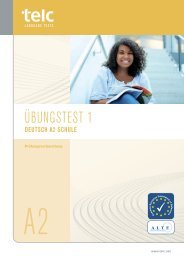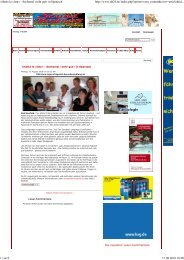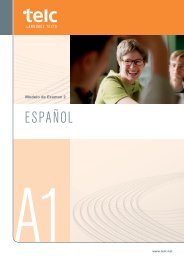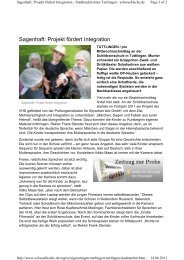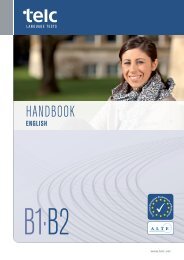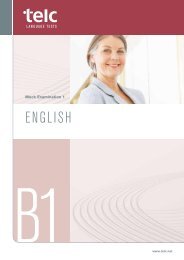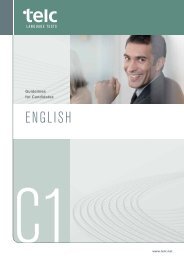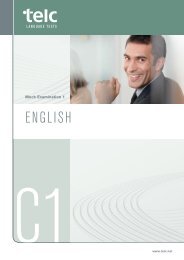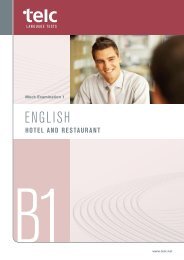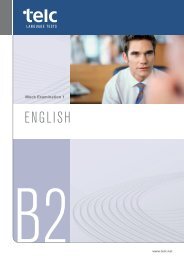Download Handbook (PDF, 4,3 MB) - telc GmbH
Download Handbook (PDF, 4,3 MB) - telc GmbH
Download Handbook (PDF, 4,3 MB) - telc GmbH
You also want an ePaper? Increase the reach of your titles
YUMPU automatically turns print PDFs into web optimized ePapers that Google loves.
Introduction<br />
0 Introduction<br />
<strong>telc</strong> English A2 · B1 is a standardised, dual-level examination which measures general language<br />
competence over two levels of the Common European Framework of Reference for Languages (CEFR)<br />
using a task-based, communicative approach. <strong>telc</strong> <strong>GmbH</strong> now offers this new examination in three<br />
different versions: the general language version <strong>telc</strong> English A2 · B1 and two target-group specific<br />
ones, <strong>telc</strong> English A2 · B1 School and <strong>telc</strong> English A2 · B1 Business. They are all part of our extensive<br />
programme of English tests.<br />
<strong>telc</strong> stands for “The European Language Certificates”. This means that <strong>telc</strong> English examinations have<br />
been developed according to European standards, but this name also emphasises that English is only<br />
one of ten languages tested by <strong>telc</strong>.<br />
The European Language Certificates were originally aimed exclusively at adults. Over time the<br />
educational landscape has changed dramatically, and <strong>telc</strong> now also offers special exams for school<br />
pupils, the latest one being the dual-level <strong>telc</strong> English A2 · B1 School examination. As a complement to<br />
this comprehensive <strong>telc</strong> English A2 · B1 <strong>Handbook</strong>, we have produced a new booklet, the <strong>telc</strong> English<br />
A2 · B1 School <strong>Handbook</strong> Supplement, which gives more detailed information on the special aspects of<br />
this examination such as the topics and vocabulary suitable for the age group.<br />
<strong>telc</strong> – language tests has a firm tradition of offering examinations to test candidates’ language<br />
competence in the working environment. For English these originally comprised English B1 for Business<br />
Purposes and English B2 for Business Purposes, now known as <strong>telc</strong> English B1 Business and B2<br />
Business, respectively. These exams assess whether learners can fulfil the language requirements of the<br />
modern workplace, particularly in oral and written communication with colleagues and business partners;<br />
it has never been the aim to test specific content or knowledge, e. g. of accountancy or economics.<br />
The latest <strong>telc</strong> English Business examination is the dual-level <strong>telc</strong> English A2 · B1 Business. The new<br />
<strong>telc</strong> English A2 · B1 Business <strong>Handbook</strong> complements the <strong>telc</strong> English A2 · B1 <strong>Handbook</strong> by providing<br />
information on the special aspects of this examination.<br />
The <strong>telc</strong> English A2 · B1 format has been carefully developed to assess a precise combination of<br />
competencies at levels A2 and B1 within one single examination. It contains tasks to test reading,<br />
writing, speaking and listening at both levels, many of which are similar to those found in the traditional<br />
<strong>telc</strong> English examinations. The CEFR describes learners at A2 level as basic users (Waystage) and<br />
at B1 as independent users (Threshold Level); however, the transition between these categories<br />
represents a major hurdle for many learners. Test takers at A2 · B1 level are likely to be those interested<br />
in being assessed on their language skills, but who are not sure which single level examination is the<br />
right one for them. The dual-level test measures and certifies which of the two possible competence<br />
levels being tested has been reached. Upon completion of the test, candidates receive a breakdown of<br />
their skills for each of the separate areas of reading and listening, writing and speaking, together with<br />
the overall level achieved: A2 or B1. Thus all participants have the chance to successfully complete<br />
the examination, which is especially encouraging for mixed-ability groups of learners. Test takers have<br />
the additional advantage of being able to find out exactly where their skills lie, as the <strong>telc</strong> Certificate<br />
precisely documents the different levels they have reached in the various language competencies.<br />
This handbook aims to describe the objectives of <strong>telc</strong> English A2 · B1 as well as the needs of the<br />
targeted learner population. It also explains how these were implemented in the development of the test<br />
format. <strong>telc</strong>’s claim that this examination is aligned to the CEFR is substantiated using evidence relating<br />
both to the examination as a whole and to each individual subtest. The test format, both for receptive<br />
and for productive skills, is described in detail, together with the marking criteria and the scoring scheme.<br />
In order to give guidance regarding the kind of vocabulary and grammar on which <strong>telc</strong> English A2 · B1 is<br />
based, lists of lexis and structures were collated. The aim of these lists is to help authors of test items<br />
<strong>Handbook</strong> <strong>telc</strong> English A2·B1<br />
5



